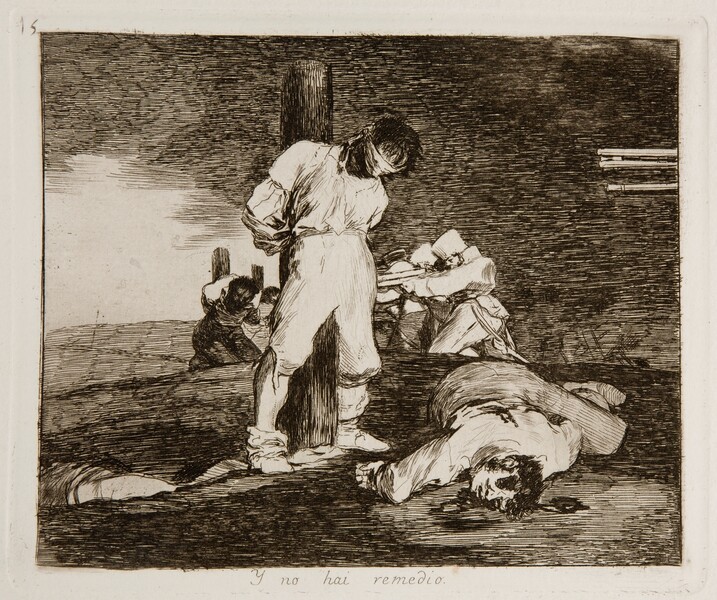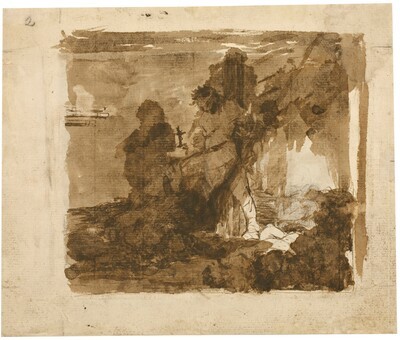- Cronología
- Ca. 1810 - 1815
- Dimensiones
- 139x164 mm
- Técnica y soporte
- Aguafuerte, buril, punta seca y bruñido
- Reconocimiento de la autoría de Goya
- Undisputed work
- Ficha: realización/revisión
- 30 Nov 2010 / 07 Nov 2024
- Inventario
- 225
22 (lower left-hand corner of plate).
See Sad presentiments of what must come to pass.
In the first state proof of this etching drypoint is used in the figures in the foreground, in the soldiers taking aim in the background, and in the fallen figure just visible on the left-hand side. This same figure is emphasized with the burin and there is some retouching in the area in the upper-right hand corner, where the etching had bitten too deeply.
The title was handwritten by Goya on the first and only print run that we know to have been made at the time, and which the painter gave to his friend Agustín Ceán Bermúdez. The title was engraved on to the copperplate at a later date, and no other modifications were made to the image for the first edition of the Disasters of War, which was printed by the Royal Academy of Fine Arts of San Fernando, Madrid, in 1863.
There is a preparatory drawing in the Prado Museum.
In the centre of the composition, in the foreground, we see a blindfolded man tied to a post. This calm, highly dignified figure is waiting, with resignation, his face turned down toward the ground, to be executed by firing squad. Beside him lies the body of another man who has just been killed, the blindfold removed from his face. We can assume that this same blindfold has been reused to cover the face of the man who is now about to be executed in the foreground. Behind him we can see two more posts and two more men, shown in the exact moment in which they are being shot by a row of soldiers, their weapons held aloft.
In this one image, Goya brings together three different phases in the death of these prisoners: the preparation, the moment of the execution, and the resulting corpse. On the right-hand side of the image he has shown the barrels of the soldier's rifles but not the soldiers themselves. Both here and in the background, the executioners' faces remain hidden from view, making it impossible for us to identify them.
The artist has used short, tightly-packed horizontal lines to recreate the sky, the earth, and the posts to which the prisoners are tied. The light areas of the scene are mainly in the spotless clothes of the accused men, alluding to their innocence. In these areas Goya has left the surface almost entirely unworked, adding only some delicate lines to construct the sleeves, the lower part of the trousers, and the shoes. Lit up in this same way is the squad of soldiers in the background, making sure that we do not overlook what is happening in that part of the scene.
This etching is closely related to the previous one, no. 14, The way is hard! , in that these two prints constitute two variations on the same theme, capital punishment. However, in And it can't be helped instead of Spaniards putting Frenchmen to death we see the reverse, with French forces executing Spaniards. In this way Goya shows how the horror is equally present on both sides. The artist finds himself utterly unable to justify the events he depicts, both here and in the previous work. He creates an analogy between these two images, in a similar way to what he did with etchings no. 2, With or without reason and no. 3, The same.
The subject of capital punishment is reiterated in some of the later prints in this series, such as no. 26, One cannot look at this, no. 31, That's tough!, no. 32, Why?, no. 34,On account of a knife, no. 35, One can't tell why, no. 36, Not in this case either and no. 38, Barbarians!.
The etching plate is conserved in the National Chalcography Museum (cat. 266)
This etching was made reusing half of the plate which Goya used for his Landscape with Cliff, Buildings and Trees
-
De grafiek van GoyaRijksmuseum RijksprentenkabinetAmsterdam1970from November 13th 1970 to January 17th 1971
-
Goya. Das Zeitalter der Revolucionen. Kunst um 1800 (1980 – 1981)Hamburger KunsthalleHamburg1980cat. 82
-
Goya y el espíritu de la IlustraciónMuseo Nacional del PradoMadrid1988from October 6th to December 18th 1988. Exhibited also at Museum of Fine Arts, Boston, January 18th to March 26th 1989; The Metropolitan Museum of Art, Nueva York, May 9th to July 16th 1989, Madrid curator Manuela B. Mena Marqués, scientific directors Alfonso E. Pérez Sánchez and Eleanor A. Sayrecat. 86
-
Francisco de Goya: Maleri, Tegning, GrafikkNasjonalgallerietOslo1996from 10th to April 14th 1996cat. 135
-
Francisco de GoyaMuseo d'Arte ModernaLugano1996exhibition celebrated from September 22nd to November 17th.cat. 15
-
Francisco Goya. Sein leben im spiegel der graphik. Fuendetodos 1746-1828 Bordeaux. 1746-1996Galerie KornfeldBern1996from November 21st 1996 to January 1997cat. 103
-
Ydioma universal: Goya en la Biblioteca NacionalBiblioteca NacionalMadrid1996from September 19th to December 15th 1996cat. 200
-
Francisco Goya. Capricci, follie e disastri della guerraSan Donato Milanese2000Opere grafiche della Fondazione Antonio Mazzottacat. 95
-
Goya. Opera graficaPinacoteca del Castello di San GiorgioLegnano2006exhibition celebrated from December 16th 2006 to April 1st 2007p. 58
-
Goya en tiempos de guerraMuseo Nacional del PradoMadrid2008consultant editor Manuela B. Mena Marqués, from April 14th to July 13th 2008cat. 94
-
Goya et la modernitéPinacothèque de ParisParís2013from October 11st 2013 to March 16th 2014cat. 54
-
Goya: Order and disorderMuseum of Fine ArtsBoston2014cat. 196
-
Zaragoza2021
-
Goya, grabadorMadridBlass S.A.1918cat. 117
-
Goya engravings and lithographs, vol. I y II.OxfordBruno Cassirer1964cat. 135
-
Vie et ouvre de Francisco de GoyaParísOffice du livre1970cat. 1015
-
Vicisitudes de algunas láminas grabadas por Francisco de Goya: Los desastres de la guerra, Los disparates, La tauromaquiaGoya1978-1979p. 287
-
Goya y el espíritu de la IlustraciónMadridMuseo del Prado1988pp. 299-300, cat. 86
-
Catálogo de las estampas de Goya en la Biblioteca NacionalMadridMinisterio de Educación y Cultura, Biblioteca Nacional1996cat. 206
-
El Libro de los Desastres de la GuerraMadridMuseo del Prado2000II, pp. 35-37
-
ParísPinacoteca de París2013p. 127
-
Goya: Order & DisorderBostonMuseum of Fine Arts Boston Publications2014p. 291
-
Goya. In the Norton Simon MuseumPasadenaNorton Simon Museum2016pp. 114-151
-
Goya. Traveler and artist of the Grand Tour (exp. cat.)ZaragozaGobierno de Aragón2021pp. 246-247

